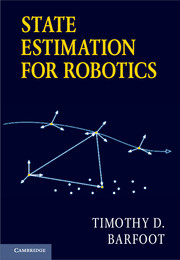Book contents
- Frontmatter
- Contents
- Preface
- Acronyms and Abbreviations
- Notation
- 1 Introduction
- Part I Estimation Machinery
- 2 Primer on Probability Theory
- 3 Linear-Gaussian Estimation
- 4 Nonlinear Non-Gaussian Estimation
- 5 Biases, Correspondences, and Outliers
- Part II Three-Dimensional Machinery
- Part III Applications
- References
- Index
5 - Biases, Correspondences, and Outliers
from Part I - Estimation Machinery
Published online by Cambridge University Press: 09 August 2017
- Frontmatter
- Contents
- Preface
- Acronyms and Abbreviations
- Notation
- 1 Introduction
- Part I Estimation Machinery
- 2 Primer on Probability Theory
- 3 Linear-Gaussian Estimation
- 4 Nonlinear Non-Gaussian Estimation
- 5 Biases, Correspondences, and Outliers
- Part II Three-Dimensional Machinery
- Part III Applications
- References
- Index
Summary
In the last chapter, we learned that our estimation machinery can be biased, particularly when our motion/observation models are nonlinear. In our simple stereo camera example, we saw that MAP estimation is biased with respect to the mean of the full posterior.We also saw that the batch ML method is biased with respect to the groundtruth and derived an expression to try to quantity that bias. Unfortunately, these are not the only sources of bias.
In many of our estimation techniques, we make the assumption that the noise corrupting the inputs or the measurements is zero-mean Gaussian. In reality, our inputs and/or measurements may also be corrupted with unknown biases. If we do not account for these, our estimate will also be biased. The classic example of this is the typical accelerometer, which can have temperature-dependent biases that change over time.
Another huge issue in many estimation problems is determining correspondences between measurements and a model. For example, if we are measuring the range to a landmark, we might assume we know which landmark is being measured. This is a very big assumption. Another good example is a star tracker, which detects points of light; how do we know which point of light corresponds to which star in our star chart? The pairing of a measurement with a part of a model/map is termed determining correspondences or data association.
Finally, despite our best efforts to negate the effects of biases and find proper correspondences, something deleterious can always happen to our measurements so that we are stuck with a datum that is highly improbable according to our noise model; we call this an outlier measurement. If we do not properly detect and remove outliers, many of our estimation techniques will fail, often catastrophically.
This chapter will investigate how to deal with inputs/measurements that are not well behaved. It will present some of the classic tactics for handling these types of biases, determining correspondences, and detecting/rejecting outliers. A handful of examples will be provided as illustrations.
Handling Input/Measurement Biases
In this section, we will investigate the impact of a bias on both the inputs and measurements. We will see that the case of the input bias is less difficult to deal with than the measurement bias, but both can be handled.
- Type
- Chapter
- Information
- State Estimation for Robotics , pp. 145 - 162Publisher: Cambridge University PressPrint publication year: 2017



